
Transforming Workspaces: Ideal Roles for Remote Designers
In today’s evolving job market, opportunities in lifestyle and retail brands are expanding dramatically. For digital nomads, seeking not only a role but a workspace that complements their lifestyle is essential. As companies adapt to remote working conditions, professionals with the right skill set are positioned to thrive in roles that blend creativity and functionality.
Spotlight on Luxury Design: Harrods' Architectural Vision
Harrods, the iconic luxury department store, is offering a unique opportunity for a technical architectural designer to join their esteemed interior design team in London. This role allows participants to work on high-end interior architecture projects, focusing on luxury experiences from the initial concept stage right through to completion. Skills in AutoCAD, Adobe Creative Suite, and SketchUp are vital, but beyond the technical requirements, candidates will learn to embrace and articulate Harrods’ culture and aesthetic, which is invaluable for personal career development.
Elevating Functionality: The Furniture Designer Role at Aman Interiors
A particularly compelling opportunity is at Aman Interiors, a brand synonymous with elegance in hospitality. The search is on for a furniture designer/developer who can create pieces that align with Aman’s ethos. This position, calling for at least three years of experience, emphasizes not just design capability but also the understanding of how well-crafted furniture can enhance remote workspaces. Digital nomads know that the right furniture can greatly influence productivity, making this role crucial in ensuring an optimal working from home environment.
Streamlining Sales: Tatjana von Stein's Studio Manager Position
For those more business-oriented, the role of a studio manager and sales support at Tatjana von Stein presents an exciting challenge. With operations spanning cities like New York, Paris, and Mallorca, this position demands exceptional organization and coordination skills. It underscores the importance of creating harmonious environments not just for clients but for those who work within those spaces—ideal for anyone interested in understanding the intersection of design and commerce.
Harnessing Technology: The Importance of BIM
As design increasingly leans towards technology, the BIM Associate role at Conran and Partners is essential for anyone wanting to stay ahead. Not only does this position demand technical prowess in software like Navisworks and Enscape, but it also incorporates client interaction and strategic project delivery across international teams. With remote work becoming the norm, understanding BIM practices can significantly enhance digital nomads’ abilities to collaborate effectively regardless of their location.
Innovation at IKEA: Project Leadership in Furniture Studies
IKEA’s Museum of Furniture Studies is seeking a project leader, which is a chance for professionals to lead initiatives that shape the future of furniture design. This role emphasizes collaboration, a valuable skill for digital nomads who often work in varying environments. Engaging with different stakeholders while managing innovative projects prepares candidates for future leadership roles, equipping them with the ability to articulate their visions in a global context.
Cultivating Design Excellence: Rockwell Group’s Hospitality Senior Interior Designer Position
Lastly, digital nomads fluent in both English and Spanish might find the Hospitality Senior Interior Designer position at Rockwell Group in Madrid particularly intriguing. With a focus on high-end residential and hospitality spaces, this role stresses significance in client coordination and adaptability—key traits that resonate with the flexible nature of remote work. By taking part in such projects, designers not only elevate their portfolios but also enhance their understanding of diverse aesthetic influences in a global marketplace.
Final Thoughts: Aligning Careers with Lifestyle Needs
As remote work continues to grow, recognizing how various roles align with personal work styles—whether through design, technology, or coordination—can significantly impact productivity and satisfaction. Exploring positions that offer flexibility and a connection to one’s lifestyle ensures that remote professionals not only excel in their careers but also enjoy the process of creating inspiring and functional workspaces.
 Add Row
Add Row  Add
Add 




Write A Comment